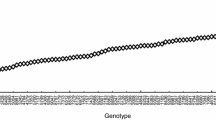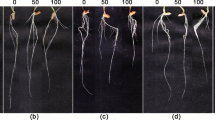Abstract
A series of hydroponic experiments and an agar culture experiment were carried out to investigate aluminum (Al) accumulation and translocation in two rice (Oryza sativa L.) cultivars (Kasalath and Koshihikari) that differ in Al resistance. Al-resistance mechanisms, including Pi exudation under Al stress and pH shifts in the rhizosphere, were also studied. Al content in rice shoots was 41 mg kg−1 on average and did not differ between the two cultivars, which demonstrated that the rice cultivars were not Al accumulators. The majority of Al (95–97%) accumulated in roots. Al content in roots in the resistant cultivar (Koshihikari) was lower than that in the sensitive cultivar (Kasalath), which indicated that Al-exclusion mechanisms were mainly acting in rice. However, the rate of Pi exudation from the whole root or root tips was very low in both cultivars and was not significantly influenced by Al exposure, and thus seemed not to be the main Al-resistance mechanism. On the other hand, experiments with pH-buffered solution and color changes following culture in agar medium containing bromocresol purple revealed that the Al-induced pH increase could not explain the high Al resistance of rice. In addition, the Al content in shoots of Koshihikari was lower after the formation of iron plaque on the root surface, whereas that of Kasalath was not lower. These results suggested that rice roots cell wall components or root surfaces such as iron plaque, rather than pH changes and/or root exudates including organic acids and phosphate, play important roles in Al resistance in rice.





Similar content being viewed by others
Abbreviations
- Al:
-
Aluminum
- ICP-AES:
-
Inductively coupled plasma-atomic emission spectrometer
- Pi:
-
Phosphate
References
Chen RF, Shen RF, Gu P, Dong XY, Du CW, Ma JF (2006) Response of rice (Oryza sativa) with root surface iron plaque under aluminium stress. Ann Bot 98:389–395
Degenhardt J, Larsen PB, Howell SH, Kochian LV (1998) Aluminum resistance in the Arabidopsis mutant alr-104 is caused by an aluminum increase in rhizosphere pH. Plant Physiol 117:19–27
Fageria NK, Carvalho JRP (1982) Influence of aluminum in nutrient solutions on chemical composition in upland rice cultivars. Plant Soil 69:31–44
Foy CD (1988) Plant adaption to acid, aiuminum-toxic soils. Commun Soil Sci Plant Anal 19:959–987
Foy CD, Burns GR, Brown JC, Fleming AL (1965) Differential aluminum tolerance of two wheat varieties associated with plant-induced pH changes around their roots. Soil Sci Soc Am Pro 29:64–67
Foy CD, Fleming AL, Burns GR, Arninger WH (1967) Characterization of differential aluminum tolerance among varieties of wheat and barley. Soil Sci Soc Am Pro 31:513–521
Ganesan K, Sankaranarayanan C, Balakumar T (1993) Physiological basis of differential aluminum tolerance in rice genotypes. Commun Soil Sci Plant Anal 24:2179–2191
Hara T, Gu MH, Koyama H (1999) Ameliorative effect of silicon on aluminum injury in the rice plant. Soil Sci Plant Nutr 45:929–936
Horst WJ (1995) The role of the apoplast in aluminum toxicity and resistance of higher plants: a review. Z Pflanzenernäehr Bodenkd 158:419–428
Horst WJ, Schmohl N, Kollmeier M, Baluška F, Sivaguru M (1999) Does aluminium affect root growth of maize through interaction with the cell wall-plasma membrane-cytoskeleton continuum? Plant Soil 215:163–174
International Rice Research Institute (IRRI) (1978) Aluminum toxicity. IRRI annual report for 1977. Los Bavos, Philippines
Jan F, Pettersson S (1989) Varietal diversity of upland rice in sensitivity to aluminum. J Plant Nutr 12:973–993
Kochian LV, Hoekenga OA, Pineros MA (2004) How do crop plants tolerate acid soils? Mechanisms of aluminium tolerance and phosphorous efficiency. Annu Rev Plant Biol 55:459–493
Ma JF (2000) Role of organic acids in detoxification of aluminum in higher plants. Plant Cell Physiol 41:383–390
Ma JF, Furukawa J (2003) Recent progress in the research of external Al detoxification in higher plants: a minireview. J Inorg Biochem 97:46–51
Ma JF, Hiradate S, Nomoto K, Iwashita T, Matsumoto H (1997) Internal detoxification mechanism of Al in hydrangea. Identification of Al form in the leaves. Plant Physiol 113:1033–1039
Ma JF, Shen RF, Zhao ZQ, Wissuma M, Takeuchi Y, Ebitani T, Yano M (2002) Response of rice to Al stress and identification of quantitative trait loci for Al tolerance. Plant Cell Physiol 43:652–659
Mugwira LM, Patel SU (1977) Root zone pH changes and ion uptake imblanlances by triticale, wheat, and rye. Agron J 69:719–722
Pellet DM, Grunes DL, Kochian LV (1995) Organic acid exudation as an aluminum tolerance mechanism in maize (Zea mays L.). Planta 196:788–795
Pellet DM, Papernik LA, Kochian LV (1996) Multiple aluminum-resistance mechanisms in wheat: roles of root apical phosphate and malate exudation. Plant Physiol 112:591–597
Ryan PR, Joseph MD, Kochian LV (1993) Aluminum toxicity in roots: an investigation of spatial sensitivity and the role of the root cap. J Exp Bot 44:437–446
Shen RF, Ma JF (2001) Distribution and mobility of aluminium in an Al-accumulating plant, Fagopyrum esculentum Moench. J Exp Bot 52:1683–1687
Shen RF, Iwashita T, Ma JF (2004) Form of Al changes with Al concentration in leaves of buckwheat. J Exp Bot 55:131–136
Taylor GJ (1991) Current views of the aluminum stress response: the physiological basis of tolerance. Curr Top Plant Biochem Physiol 10:57–93
Vasconcelos SS, Jacob-Neto J, Rossiello ROP (2002) Differential root responses to Aluminum stress among Brazilian rice genotypes. J Plant Nutr 25:655–669
Zhao QG (2002) The space–time variability of soil degradation in red soil area in East China, the mechanisms and regulation methods, Science Publisher, Beijing, pp 70–80 (in Chinese)
Zheng SJ, Yang JL, He YF, Yu XH, Zhang L, You JF, Shen RF, Matsumoto H (2005) Immobilization of aluminum with phosphorus in roots is associated with high aluminum resistance in buckwheat. Plant Physiol 138:297–303
Zhou JH, Pan WH, Xu AB, Zhu MY (1997) Aluminum tolerance of different barley cultivars in a constant system of pH. J Hangzhou Univ (Nat Sci) 24:85–90 (in Chinese)
Acknowledgments
This research was supported financially by the National Natural Science Foundation of China (40371072, 40621001) and the CAS Innovation Program (ISSASIP0708).
Author information
Authors and Affiliations
Corresponding author
Additional information
Communicated by G. Klobus.
Rights and permissions
About this article
Cite this article
Chen, R.F., Shen, R.F. Root phosphate exudation and pH shift in the rhizosphere are not responsible for aluminum resistance in rice. Acta Physiol Plant 30, 817–824 (2008). https://doi.org/10.1007/s11738-008-0186-y
Received:
Revised:
Accepted:
Published:
Issue Date:
DOI: https://doi.org/10.1007/s11738-008-0186-y




